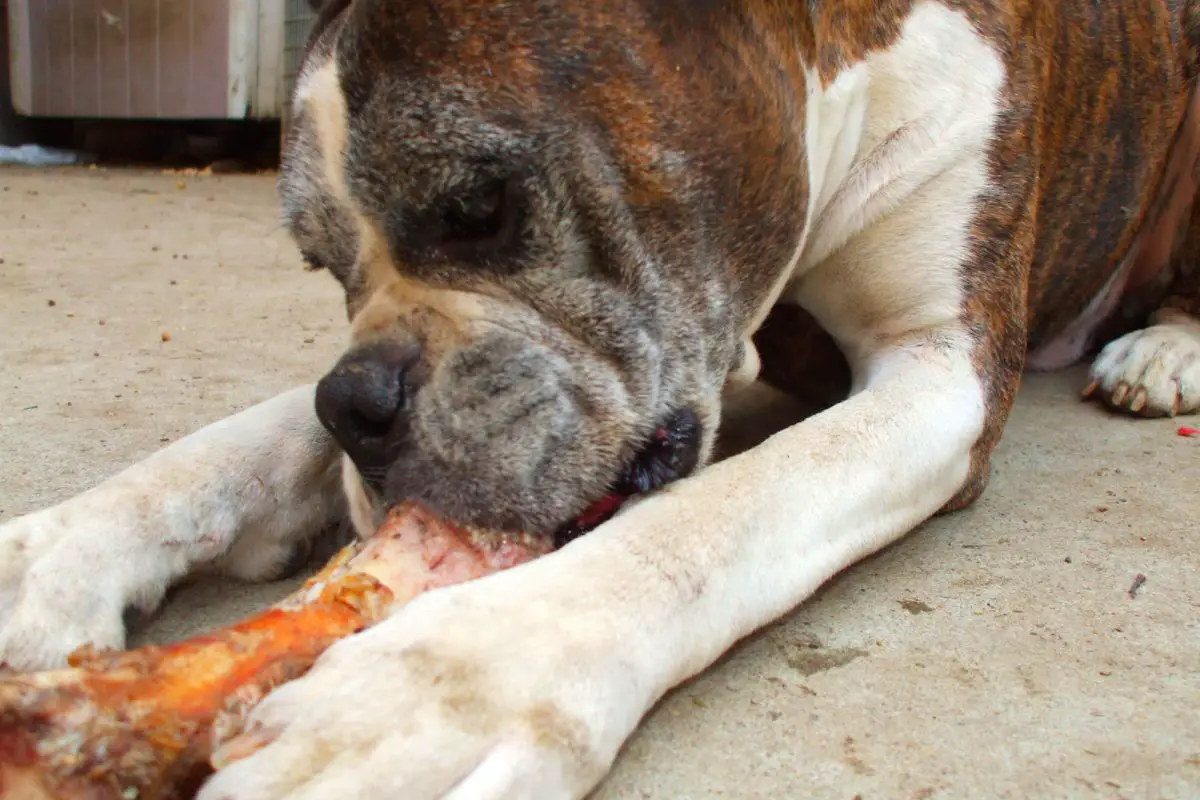This post contains affiliate links.
Every dog owner looks for treats for his pup, whether for training, supplementing the animal’s diet, or just giving the dog a treat to make him happy. On the long list of things we buy our animals to eat or chew on is chicken feet, easily the most horrifying-looking thing we feed our dogs regularly.
Dogs can eat chicken feet as they offer several health benefits, are very tasty, and will satisfy most dogs. While they aren’t much to look at, chicken feet have high protein levels and other compounds that can contribute to your dog’s health and aid in giving your pet a longer, healthier life.
While there are caveats to feeding chicken feet to dogs, as there are with nearly anything you might choose to give your pup, overall, these make an excellent choice for treats. Let’s get started before your pup bowls you over for these treats!
Table of Contents
Are Chicken Bones Bad for Dogs?
Under no circumstances should dogs be given chicken bones that have been cooked–boiled, baked, or fried. When chicken bones react to high heat, their physical structure changes, they get brittle and take on some physical qualities similar to glass.
When a dog bites down on a cooked chicken bone, it splinters, and the resulting hard, sharp pieces can easily cut your dog’s mouth or worse. Choking can be an issue because the bone splinters can get lodged in its throat.
The hard bone fragments can wreak havoc on your dog’s stomach and intestines, so the overarching message here is that you should never, ever feed your dog cooked chicken bones.
Chicken feet are mostly bone. Sure, they’re very small bones, but they can still, when cooked, injure your dog. So chicken feet can be safely fed to your dog, provided they’re not cooked.
The entire chicken foot is edible, even the nails, although those may be too sharp or hard for your dog. Many dog owners cut the nails off before feeding the feet to the dogs (garden clippers or kitchen scissors work equally well), but this is not a requirement.
Why Chicken Feet Are Good for Your Dog
Chicken feet can contribute to your dog’s health, making them more than just a treat. Mainly, the benefits relate to joint health and dental health–two critical parts of your dog’s life.
Chicken Feet Contain Glucosamine Which Helps Joint Health
About 20 percent of all dogs deal with arthritis–specifically, osteoarthritis, the same kind that afflicts many humans as they age. It’s an ailment that breaks down cartilage, ligaments, and tendons. Joints swell up with this condition, which means that arthritis damages joints and causes discomfort and pain.
Once arthritis develops, what’s left is management.
You’ll start to suspect arthritis in your dog if you notice a limp, or if it develops a hesitancy when it comes to jumping up or down from things. If you see these, or if your dog begins having trouble getting up or down, it’s time for a visit to the vet.
Before those symptoms appear, though, veterinarians agree that prevention is the best approach. One way to practice prevention in dogs is to augment their intake of glucosamine and chondroitin, both of which aid in joint health.
Chicken feet provide high amounts of both for your dog.
Even if your dog already has arthritic symptoms, these compounds can help manage the pain and stiffness that will make running, playing, jumping, and getting up and down difficult for your pooch.
Whether preventing or treating arthritis, ranging from between two and six dollars per pound, chicken feet may be the cheapest treatment.
You Can Use Supplements Instead of Chicken Feet
If, after evaluating chicken feet, or after looking at them, you decide they just aren’t for you or your dog, glucosamine and chondroitin supplements are available commercially. If you’ve ever tried to give your dog a pill, you cannot argue that chicken feet would be the dog’s preferred delivery method.
Alternatives would be supplements that are also snacks available on Amazon.com, like Zuke’s Hip Action Beef, or an additive for your dog’s food like Zesty Paws 8-in-1 Flavor Infusions.
Those treats can be highly processed foods, however. Pet owners concerned with food processing or who are looking for organic options for their dogs’ food and snacks may opt against those packaged treats.
For all the supplements out there, chicken feet are cheaper, and you can even make them yourself, but more on that in a bit. However you go about getting your chicken feet, they’re definitely a treat.
Watch this video of a happy dog eating a few of them, obviously thrilled with his lot in life:
Chicken Feet Are Good for Dog’s Dental Health
Puppy breath is one thing, but dog breath is quite another. And if your dog is missing teeth, it can prove to be dangerous for your dog’s overall quality of life.
In light of these facts, there are those people out there who brush their dog’s teeth. However, for most of us, that’s too much. For some dogs, it’s unacceptable behavior for a human to try on them.
Canine dental health has given rise to a whole industry of chew toys, from the likes of Dog Treat Outlet Rawhide Chews to fancy plastic squeaky things like Rosmax Dog Chewing Stick (both available on Amazon.com).
Chicken feet work just as well and, unlike those chews, provide additional nutrition for your dog. After all, chews aren’t digestible, and especially with something like the rawhide chews, dogs often swallow some of its pieces.
Eating chicken feet will help remove plaque from your dog’s teeth, as well as any tartar build-up– both things that are bad for your dog’s teeth and can contribute to bad breath. If you have a chicken farm with more birds, you now have something to do with those leftover chicken feet.
How Do I Find Chicken Feet?
There are two ways to find this treat: either you buy them or make them yourself. Both options have their upsides, and the downsides depend mainly on your access to chickens who no longer need their feet, such as at a butcher shop.
When purchasing chicken feet, you have three options according to Kip & Twiggy’s:
- Dehydrated chicken feet that are cleaned and dehydrated will last about six months.
- Puffed chicken feet that have been air-dried will retain a few more nutrients than their dehydrated counterparts and will keep for about six months as well.
- Raw chicken feet from the butcher shop or from the chicken you just killed for dinner will last in your fridge or freezer for as long as raw or frozen chicken you plan to eat for yourself will keep.
These are all okay for your dog to eat, even the raw ones. While humans are never supposed to eat raw chicken, this is not an issue with dogs. One suggestion for feeding your dog raw chicken feet is to freeze them first, which will slow your dog’s progress as he goes to town on his new favorite treat.
There are no additional health benefits to frozen chicken feet. Freezing them simply allows the treats to last a little longer.
Raw, room-temperature chicken feet are safe. If you have access to raw chicken feet, you can dehydrate them yourself, an especially cost-effective measure if you live on a chicken farm.
Check out this demonstration video from a guy I wish was my next-door neighbor:
Chicken feet also allow for less waste, as the feet are one part of the chicken that would otherwise be thrown away, making this dog treat environmentally friendly.
If you’re feeding your dog chicken feet from your leftover chicken parts at your chicken ranch, you’ll want to clean the feet before feeding them to your family pet. When attached to a chicken, those chicken feet walk over chicken poop and who knows what else on the ground, so all that will need to go, or it will end up in your dog’s digestive tract.
Are There Other Benefits to Chicken Feet?
In addition to the glucosamine and chondroitin mentioned above, chicken feet are a good source of protein–something every dog needs as a regular part of their diet.
Of course, too much protein can also be a problem for any creature, but since chicken feet are small, the recommended “dose” of one to three of them a day would not be too much. More than three a day regularly is probably too much.
Generally, dogs should take in one gram (0.002 lb) of protein per pound of their ideal body weight. Augmenting their intake with chicken feet is a good way to ensure they’re getting their daily needs. However, a dog can have too much protein, so while pups aren’t known for their moderation, their owners should be.
In addition, chicken feet are a low-calorie option for snacks, as there isn’t any meat in a chicken foot. Rather, they’re skin, cartilage, tendons, and bones–very small bones, at that. None of these have particularly high amounts of calories, so this is, again, an excellent snacking option that won’t fatten up your dog.
Because of all those tendons and cartilage and stuff, the protein and fat content are high in chicken feet, also good things to keep in your dog’s diet.
Possible Downsides to Chicken Feet
If your dog is obese, treats are probably not recommended at all, no matter their protein content. Also, if your vet has forbidden you from feeding your dog chicken, chicken feet would be included in that moratorium.
As pancreatitis can affect some dogs, and as the fat content in chicken feet can exacerbate this condition, they shouldn’t eat chicken feet. Of course, there are dogs out there who are allergic to chicken, so for these dogs, chicken feet are a no-no.
There’s also an argument to be made about the kind of fat found in chicken.
There’s a high concentration of what’s called Omega-6 fatty acids in chicken meat (and feet), a compound thought to lead to increased inflammation. As inflammation is the culprit in many ailments in dogs and people, this may be something pet owners choose to avoid.
Finally, some people– whether they own dogs or not–express concern about what goes into chickens before they arrive at the dinner table or your dog’s snack time.
Antibiotics and other preservatives are a big bugaboo in the discussion of what chickens eat, as are many ingredients in the average bucket of chicken feed. Whatever the chicken eats will, by the transitive property, get eaten by your dog, so if these are concerns of yours, chicken feet might not be a good choice for a dog snack.
When Can a Dog Start on Chicken Feet?
Unless you have a young puppy, today is a good day to start your dog eating chicken feet for an occasional treat. Puppies under four months of age are generally considered too young for this treat. Even though uncooked chicken bones aren’t dangerous for dogs, young puppies don’t yet have the teeth for them.
Also, no matter your dog’s age, you’ll want to monitor him the first couple of times you give him chicken feet–or any new snack, for that matter. You just never know how your specific dog might react.
Conclusion
Every dog loves a treat, and chicken feet fall into that category.
Uncooked chicken bones are safe for dogs, including chicken feet, which can help with arthritis prevention and management and is suited for maintaining your dog’s dental hygiene.
Other than waiting for your puppy to be old enough to handle snacking on chicken feet, there are few prohibitions on this treat. Any health concerns revolving around processing chicken will be the same for chicken feet as they would be for chicken meat and might be something pet owners consider. But they’re a healthy snack that your dog will love.
Related Articles
- Can Dogs Eat Cilantro? (We Find Out)
- Can Dogs Eat Mac and Cheese? We Find Out
- Can Dogs Eat Beef Jerky? (We Ask the Experts)
- Is Bologna a Good Dog Treat? (We Find Out)
- My Dog Ate Vienna Sausage. Will He Be Okay?
- Can Dogs Eat Chicken Nuggets? Yay or Nay?
Sources
- Campfire Treats: Can Dogs Eat Chicken Feet? | Health Benefits & What to Avoid
- Chihu Life: Can Dogs Eat Chicken Feet? Here’s What To Know
- Dogs Naturally: Raw Chicken For Dogs: Why I Stopped Feeding It
- Kip and Twiggy’s: A Guide to Chicken Feet for Dogs (by Jo the Vet)
- Pets Lovee: Can Dogs Eat Chicken Feet?
- ScienceDirect: Omega-6 fatty acids and inflammation
- TrainYourGSD: Can Dogs Eat Chicken Feet: Is There Any Health Risk?
- YouTube: How To Turn Chicken Feet Into Dog Treats!
Mrdogfood.com is a participant in the Amazon Services LLC Associates Program, an affiliate advertising program designed to provide a means for sites to earn advertising fees by advertising and linking to Amazon.com. We also participate in other affiliate programs which compensate us for referring traffic.




